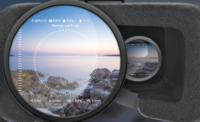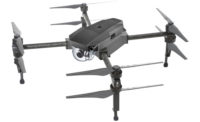Black & Veatch announced in December the successful conclusion of a 60-mile-log, non-stop, proof-of-concept drone-based inspection flight conducted by a remote pilot in a command center miles away in rural Illinois.
The flight was made on Nov. 8 as part of three days of test flights operating beyond visual line of sight (BVLOS) using a hybrid drone with rotors for vertical takeoffs and landings but also with fixed wings and a forward-facing prop for long runs. The route took it from a command and control center at an airport five miles from the area of interest, and then two passes up and down a twisting, 23-mile-long set of electrical transmission lines, and then back to its point of departure.
The UAV used was a gas-powered HQ-90 (since re-branded an FVR-90) from Latitude Engineering. “You can’t really go that far with battery power,” notes Jamare Bates, an FAA-certified remote unmanned aircraft systems pilot who heads UAS operations at Black & Veatch. An observer followed in a Cessna chase plane provided by the University of Iowa. “We had a UAV pilot in the aircraft with eyes on the UAV, but he was just a visual observer there to maintain radio communications with the pilot at the command center,” Bates says.
The flight was the culmination of a two-year-long project testing “beyond visual line of site” commercial drone operations that was conducted under a special permit from the Federal Aviation Administration. The project was developed and managed by Black & Veatch, together with the St. Louis-based utility Ameren, and Collins Aerospace, along with numerous other technology partners, including the Universities of Iowa and North Dakota.
In a statement, Ameren noted the potential of innovations like BVLOS drones to help the utility deliver safe, reliable and affordable energy. James Pierce, BVLOS program manager and lead of Ameren’s Central Unmanned Aircraft System (UAS) Dept. said "We are pleased with the outcome of this 60-mile flight, which demonstrates our commitment to identifying advancements in drone technology to increase reliability and customer satisfaction. Ultimately, the successful deployment of BVLOS drones could revolutionize how Ameren assesses and evaluates the condition of our systems."
Bates says, “Amerind was looking for the ability to increase the frequency of their inspections and to get better data, such as using different types of sensors and detection equipment up in the air. We presented them with a plan to do some innovative testing to get to that goal.”
The mission targeted a transmission line leading from a power plant in Newton, north to a substation near Casey. The 60-mile flight was the longest in a series of progressively longer flights to test the communications and operational technologies and procedures. “We have always had this crawl, walk, run mentality,” Bates says, noting that the first flight in the series, of five miles, was conducted in 2017.
“It’s not simple”, adds Bates. He says the crew had wind speed challenges and was constantly monitoring the weather, because the drone operations are different in different weather conditions. Piloting was also made more difficult by the relatively slow, 40-mph speed of the flight. “Understanding that is part of the goal of doing this testing,” says Bates.
The project also required installation of a temporary radio network to maintain a robust and reliable command and control link with the pilot in a command center at an airport in Casey. Bates says the team partners from Rockwell Collins (now Collins Aerospace) provided the communications expertise.
Many utility companies already have communications networks built into their transmit line systems, Bates adds, and in this case the project was able to leverage some of Ameren’s own infrastructure to support the project. He predicts that such inspections will become commonplace in the future as projects like this one demonstrate that BVLOS operations can be conducted safely.
“In the future, you will have build-out, and, as with much of new technology, you are going to try and leverage as much of what you already have as you can. The early adopters are going to leverage their own capabilities — but they will need companies like us to integrate into their own assets,” Bates says.
“One of the important things we are trying to get people to understand is, it really is a collaboration of partners to make and activity like this come together. We know our strengths and we know the strengths our partners can bring, and that’s the way the FAA works: It looks for teams of people that are good stewards of the airspace.”
He says, once established, BVLOS operations will only be limited by the range of the aircraft. “We have heard of aircraft being built now with the plan of going 200 miles,” Bates says. “You would need to have a ground-based infrastructure spread throughout your route and you would need overlap. From a design perspective, we would design that into the system. You can scale it up: you don’t necessarily have a limiting factor."
“It’s proving the concept that we can do this safely, and from the FAA perspective, they want to see more of this, see more flight hours, and see safe flight operations. This one involved using a lot of training wheels that can be pulled away,” Bates added.





Post a comment to this article
Report Abusive Comment